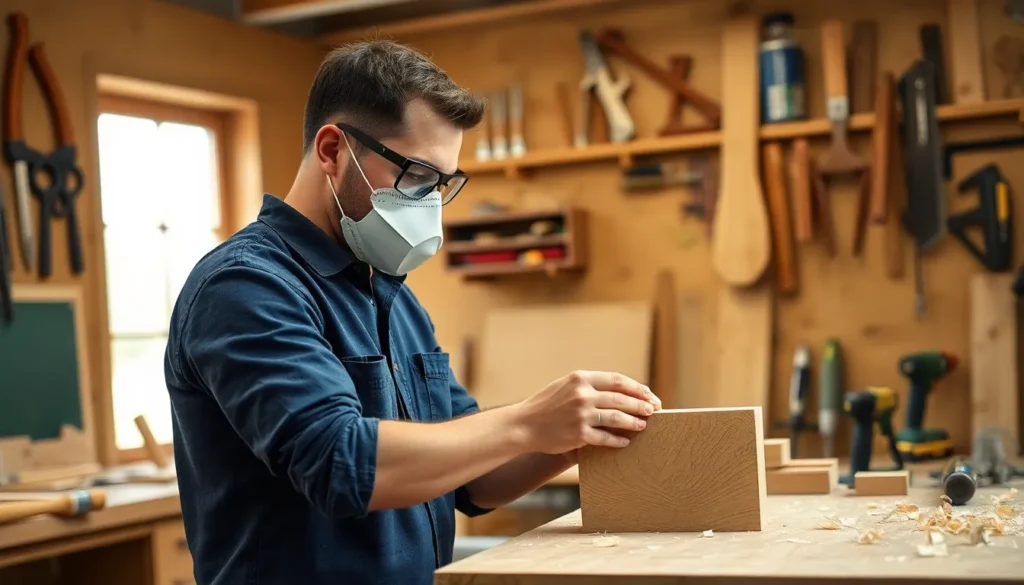Woodworking isn’t just a hobby; it’s a delightful dance with wood that can turn a simple plank into a masterpiece. Imagine transforming a pile of lumber into a stunning piece of furniture or a quirky birdhouse that even the birds will envy. Whether you’re channeling your inner carpenter or just looking to impress your friends with a handmade gift, woodworking offers a creative outlet like no other.
How To Get Into Woodworking
Woodworking encompasses a range of skills used to create items from wood. Techniques include carving, joinery, and finishing, each contributing to the final product’s appearance and durability. Safety remains paramount, so individuals should invest in personal protective equipment like goggles and masks.
Tools play an essential role in woodworking. Common tools consist of saws, chisels, drills, and sanders. Beginners may find starter kits useful, providing essential equipment without overwhelming expense. Advanced woodworkers often seek specialized tools for more complex projects.
Materials also influence woodworking projects. Softwoods, such as pine and cedar, offer ease of use for novices. Hardwoods, including oak and maple, provide durability and rich aesthetics for seasoned craftspeople. Understanding wood types helps individuals choose appropriate materials for specific projects.
Projects span from simple to intricate. Beginner projects may include shelves or picture frames. Intermediate projects might involve furniture, while advanced woodworkers often tackle custom cabinetry or detailed carvings. Selecting the right project keeps motivation high and encourages learning.
Community engagement enhances the woodworking journey. Online forums, local workshops, and woodworking clubs offer opportunities for skill exchange. Networking with fellow woodworkers can provide support and inspiration, helping to develop techniques and craftsmanship.
Experimentation fuels creativity. Individuals should feel free to modify designs or experiment with techniques. Mistakes often lead to valuable learning experiences, refining skills and enhancing future projects. Embracing challenges fosters growth in woodworking.
Essential Tools for Beginners

Woodworking requires a set of essential tools that cater to both hand and power needs. These tools help beginners embark on their woodworking journey with ease.
Hand Tools
Hand tools remain fundamental in woodworking. Essential options include a handsaw, which efficiently cuts wood, and a chisel, perfect for shaping and carving. A tape measure ensures precise measurements, while a square helps maintain right angles for joints. Additionally, a hammer aids in driving nails and assembling pieces. Frequent use of these tools builds confidence in basic skills, allowing for smaller projects to flourish.
Power Tools
Power tools offer speed and efficiency for those new to woodworking. An electric drill simplifies drilling holes, making it ideal for various projects. A jigsaw supports intricate cuts, perfect for creating curves and shapes. A circular saw serves a versatile purpose, handling straight cuts with ease. With a random orbital sander, achieving a smooth finish becomes straightforward. Beginners often find that power tools significantly streamline their woodworking tasks, enhancing overall productivity.
Choosing the Right Wood
Selecting the appropriate wood is essential in woodworking. Beginners should first consider the types of wood available and where to source these materials.
Types of Wood
Softwoods, such as pine and cedar, appeal to novices due to their ease of use and workability. Hardwoods, including oak and maple, offer strength and visual appeal for experienced woodworkers. Each wood type features unique characteristics. For example, pine is lightweight and affordable, making it suitable for practice projects. Cedar resists decay, ideal for outdoor items like birdhouses. Oak provides durability, ensuring longevity for furniture pieces. Maple’s fine grain results in a polished look for intricate designs. Understanding these differences helps choose the right wood for specific projects.
Where to Source Your Wood
Local lumberyards present a variety of wood options, usually including both softwoods and hardwoods. Home improvement stores typically provide a selection of popular varieties in pre-cut sizes. Additionally, sourcing reclaimed wood from construction sites or salvage yards promotes sustainability and adds character to projects. Online retailers offer convenience and access to specialty types that may not be available locally. Engaging with community woodworking events often leads to discovering local suppliers or unique materials. Selecting the right source enhances woodworking success.
Basic Woodworking Techniques
Woodworking involves essential techniques that form the foundation of creating quality projects. Key skills include measuring, marking, cutting, and shaping wood accurately.
Measuring and Marking
Measuring and marking are crucial first steps in any project. Accurate measurements prevent mistakes that can lead to wasted materials. Use a tape measure for long lengths and a square for ensuring right angles. Mark lines clearly using a pencil to enhance visibility. Understanding measurements in both imperial and metric units provides versatility. Measurement mistakes, such as incorrect lengths, can complicate assembly. Many woodworkers recommend double-checking measurements before proceeding. Taking time in this phase guarantees a smooth process later on.
Cutting and Shaping
Cutting and shaping come next, adding form to the wood. Woodworkers often use saws like hand saws or circular saws for straight cuts. Precision plays a vital role when shaping wood to fit specific designs. Techniques such as sanding refine shapes by smoothing edges and surfaces. Using the right tools for the job, like chisels or routing machines, simplifies the task. Cutting along lines precisely helps maintain design integrity. Techniques vary based on project complexity or desired outcomes. Adapting methods to match each task enhances efficiency in achieving the final product.
Starting Your First Project
Selecting the right project sets the foundation for a successful woodworking journey. Beginners should consider projects that offer manageable challenges, such as a simple bookshelf or a picture frame. Enthusiasts can gradually increase complexity as they gain confidence and experience.
Prioritizing accuracy enhances the overall quality of any project. Accurate measurements prevent costly mistakes, so using a tape measure and a square proves essential. Marking cut lines clearly ensures a clean and precise finish during cutting.
Choosing the right type of wood matters significantly. Softwoods, like pine and cedar, often serve as excellent starting materials for novices due to their ease of handling. Hardwoods deliver durability and aesthetic appeal for more advanced projects, giving woodworkers a sense of accomplishment.
Focusing on essential techniques helps build a solid skill set. Mastering cutting and shaping techniques involves using various saws and sanders effectively. Learning to sand surfaces properly results in a smoother finish while enhancing the product’s overall appearance.
Gathering necessary tools before starting a project proves beneficial. Essential tools include chisels, drills, and clamps, all of which facilitate the woodworking process. Investing in quality tools leads to better results and increased satisfaction.
Emphasizing safety at every stage enhances the woodworking experience. Wearing safety goggles and masks protects against dust and debris during cutting and sanding. Understanding proper lifting techniques also prevents injuries, allowing more enjoyable project completion.
Seeking feedback can foster growth in skill and confidence. Sharing completed projects with friends or online communities provides valuable insights and encouragement. Engaging with others encourages learning and inspires creativity in future woodworking endeavors.
Conclusion
Woodworking offers a fulfilling way to express creativity while developing valuable skills. By starting with manageable projects and focusing on accuracy and safety, beginners can build confidence and enjoy the process. Engaging with the woodworking community can provide support and inspiration, making the journey even more rewarding. Embracing mistakes as learning opportunities fosters growth and innovation. With the right tools and materials, anyone can transform their woodworking dreams into reality. So grab those tools and start creating something unique today.

